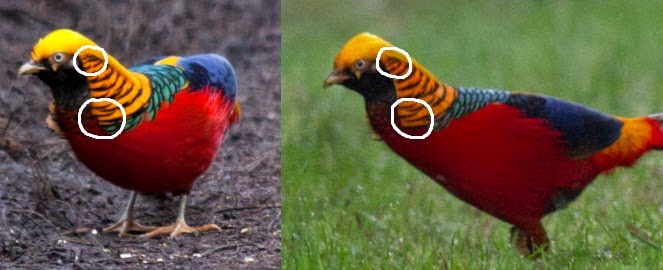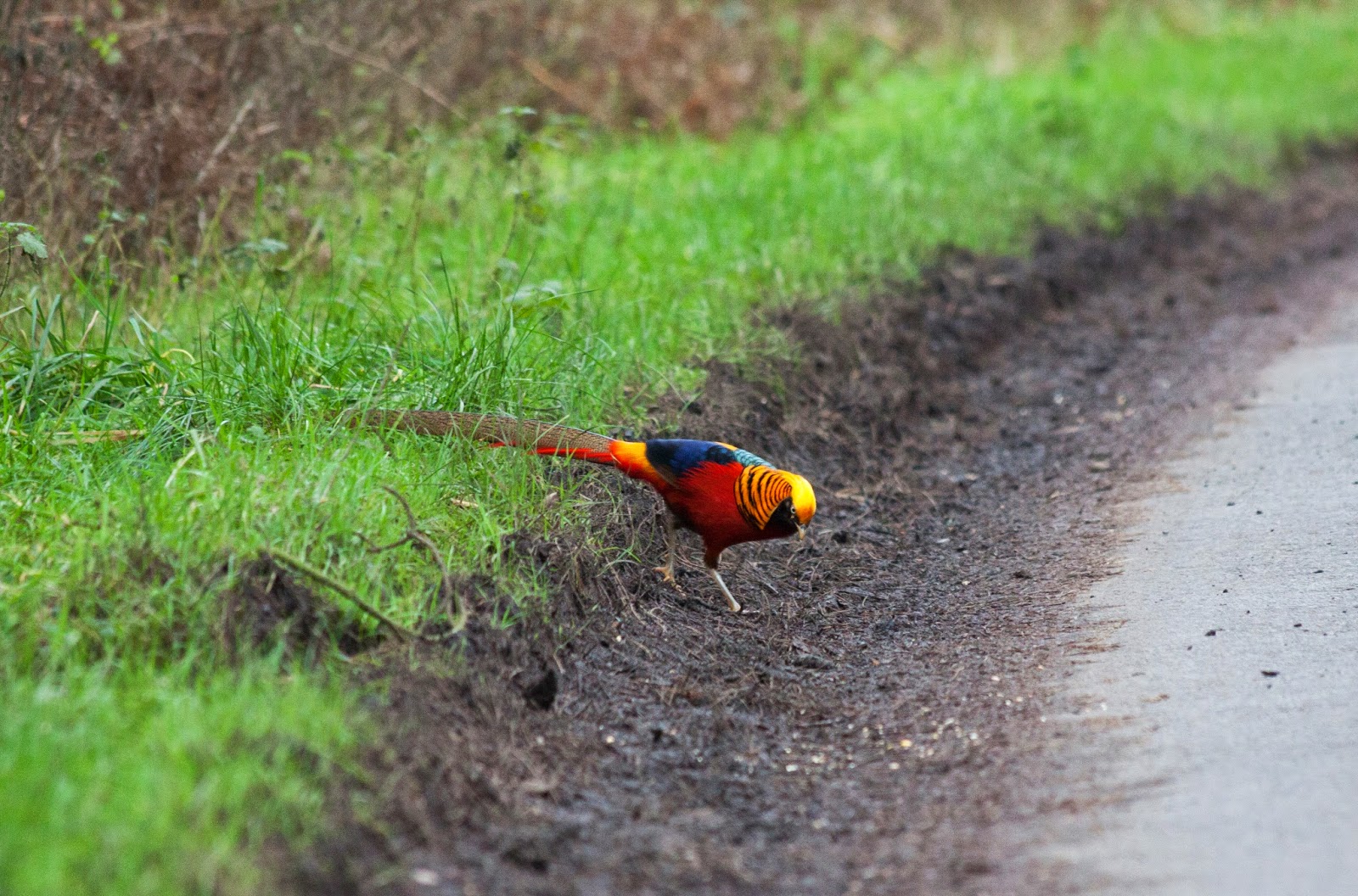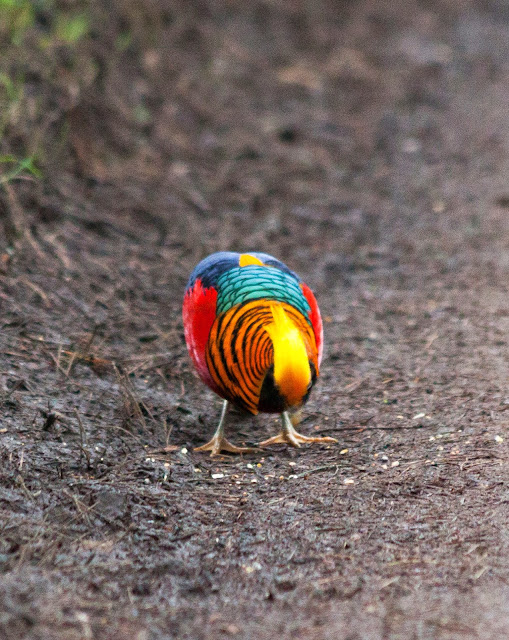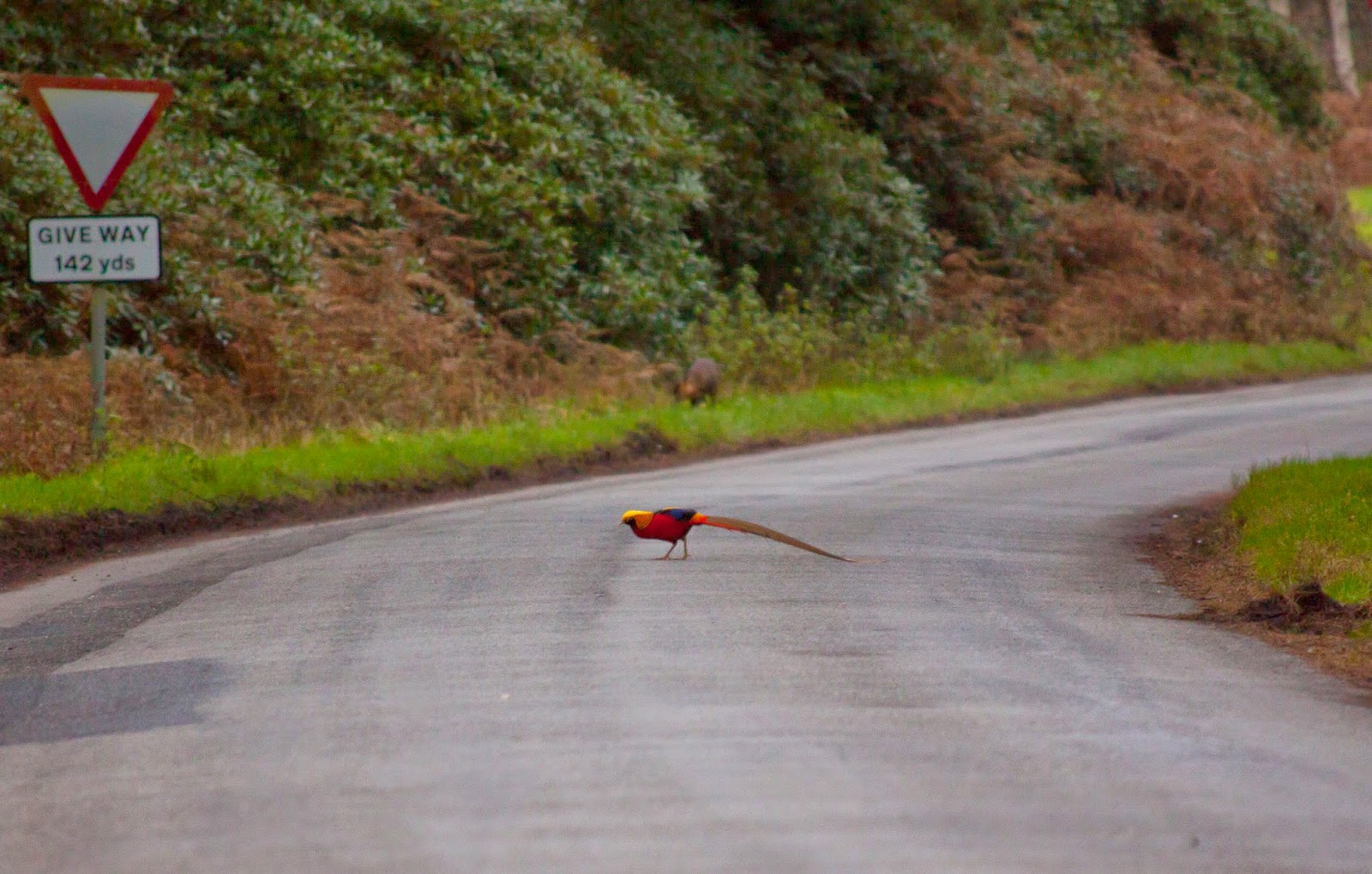Before Christmas I managed to
persuade Alex to drive us both down to Norfolk so I could catch up with a much
anticipated bird – the Golden Pheasant!
Having made two prior visits
to their favoured hotspot of the Wolferton Triangle and not seen any, this was
my first dawn visit and I was hoping for some success and a case of third time
lucky! The previous evening we had sprinkled some seed along the roadside at
one particular male’s favourite spot on the road, and returned early the next
morning whilst it was still dark to watch and wait.
The first bird we clocked on
to was a Woodcock busy feeding on the soft roadside verge – the only views I’ve
actually had of this species on the ground. However, with the Goldies showing
best early in the morning, and having been there since dawn with the time fast
approaching 9 o’clock, we were getting a little concerned that we hadn’t seen
anything – nearly an hour and a half in to the sunlight and still no sign of
our target!
Several false alarms of Common
Pheasants on the roadside gave us a little hope, then, as we turned the corner
driving back along the North road – BOOM!! – he was there!!!! Success!!!!
The male in all his
resplendent glory was stood at the side of the road, busy feeding on the
previous nights seed in the company of the slightly larger Common Pheasant. Not
wanting to startle him, we watched from a distance before slowly approaching in
the car, looking on as he slowly crossed the road (interestingly chasing off
the Common Pheasant quite aggressively) and continued to feast on the bounty of
seed we had left out for him.
Usually seen quickly crossing
the road before disappearing in to the thicket of Rhododendrons, this was a
great opportunity to observe him at our leisure, providing around ten minutes
in which we took in the absolutely stunning plumage, vivid feather colours and the
magnificent tail.
After studying some photos of
a bird seen a few weeks earlier (kindly supplied by Harry Murphy - shots on the right) I was
interested to find out if this was in fact the same individual. Studying the
two shots side by side and comparing the feather patterns on the neck in
certain spots, it’s clear to see they match up and that this is indeed the same
male. Also seen in the exact same
spot, he seems to favour the area just in front of the sign near the junction
at the end of the North Road adjoining the main road.
 |
| The bottom right feathers and top feather patterns are identical |
 |
| The top feathers and the bottom corner feathers again show exactly the same markings |
An in-depth look at the
population:
Having been kept in captivity
in the UK since 1725 and first released in to the wild in Norfolk in the
1840’s, Golden Pheasants have thrived in this particular spot and it is one of
the best places in the country to see this brightly coloured wonder. Indeed,
the UK birds are the only known fully established population in the wild
outside China that are fully self-sustaining (included on the British list
under Category C1E).
However, in recent years their
numbers have been seen to decline, perhaps due to an increase in predation of
adults and chicks from foxes, and it is unknown as to how many individuals may
actually be left. The total UK population was estimated to be between just 85
and 118 pairs in 2000, and 15 years later this has fallen dramatically, so it
is unknown just how many are still residing in this small patch of woodland. It
would be interesting to determine how many birds are indeed left here, and
whether all of the recent sightings have been of this same male. Indeed, with
wild adult birds living for around 5-6 years, once he disappears will the
number of sightings reduce significantly?
 |
| The male in his favourite spot just beyond the junction on the North Road |
This dark throated form, the
variation “obscurus” (as seen in
these birds) is commonly found and well known in captive populations of pure
bred birds, and is widely seen through the captive rearing of Golden Pheasants
due to the limited genetic flow and higher chance of gene mutation as a result.
 |
| The dark throat seen in var. obscurus is clearly visible |
When a population is heavily
inbred (due to the small numbers of individuals) as seen in the dwindling
population of the Wolferton birds, such mutations are far more likely to occur,
and in recent years the Breckland birds (another location in the UK) have also
begun to show this characteristic. It is only natural that as the number of
birds gets smaller and smaller, the mutation of the dark throat becomes more
pronounced in those individuals that are left which are then left to breed with
one another. With this species reluctance to cross open country, either via
flight or on foot, dispersal and colonisation of new areas is extremely
limited, with a lack of fresh genetic material contributing to the limited gene
pool in the Wolferton Population.
It is also worth noting that
no Lady Amherst’s Pheasants have been reported in the area (nor at the Brecklands
site) and there is no evidence that they ever have, so it is extremely unlikely
that hybridisation is the cause of the dark throat patch. Studying photos of
hybrid Lady A x Golden Pheasants, the individuals all seem to display
characteristics of both parents, red, blue and yellow feathers on the body, but
white and black tails and neck feathers (as well as a distinct ‘scruffy’
appearance typical of hybrid birds). This is not the case with any of the
Wolferton birds however, with the classic gold and black tail and neck feathers
present with no hint of white.
 |
| Not a hint of white can be seen in the feathers of this individual indicating a lack of hybridisation |
However, we also need to delve further in to the history of the released birds, as it is often stated that there are NO pure Lady A or Golden Pheasant populations anywhere in Europe. The captive stock released over 100 years ago may well have contained genes from both species (albeit 99% of one parent) with crosses somewhere in the parentage long ago in captivity.
 |
| The male showing off the beautiful feather patterns and fiery head crest |


I like this article because you present the very informative facts of Pheasant Bird. I also like this Golden Pheasant Bird pictures that you place here.
ReplyDelete